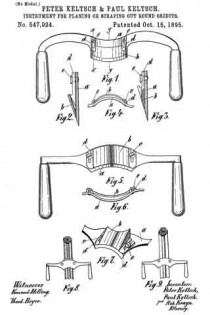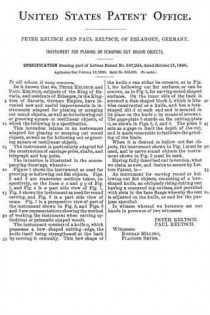
| PLEASE NOTE: The images presented on this page are of low resolution and, as a result, will not print out very well. If you wish to have higher resolution files then you may purchase them for only $2.95 per patent by using the "Buy Now" button below. All purchases are via PayPal. These files have all been cleaned up and digitally enhanced and are therefore suitable for printing, publication or framing. Each zip package contains all the images below (some packages may contain more), and purchased files can be downloaded immediately. |
UNITED STATES PATENT OFFICE.
_________________
PETER KELTSCH AND PAUL KELTSCH, OF ERLANGEN, GERMANY.
INSTRUMENT FOR PLANING OR SCRAPING OUT ROUND OBJECTS.
_________________
SPECIFICATION forming part of Letters Patent No. 547,924, dated October 15, 1895.
Application filed February 12, 1895. Serial No. 538,080. (No model.)
_________________
To all whom it may concern:
Be it known that we, PETER KELTSCH and PAUL KELTSCH, subjects of the King of Bavaria, and residents of Erlangen, in the Kingdom of Bavaria, German Empire, have invented new and useful improvements in instruments adapted for planing or scraping out round objects, as well as for hollowing out or grooving square or rectilinear objects, of which the following is a specification.
This invention relates to an instrument adapted for planing or scraping out round objects, as well as for hollowing out or grooving square or rectilinear objects.
The instrument is particularly adapted for the construction of carriage-poles, shafts, and telegraph and hop poles.
The invention is illustrated in the accompanying drawings, wherein —
Figure 1 shows the instrument as used for grooving or hollowing out flat objects. Figs. 2 and 3 are transverse sections taken, respectively, on the lines x x and y y of Fig. 1, and Fig. 4 is a part side view of Fig. 1. Fig. 5 shows the instrument as used for round carving, and Fig. 6 is a part side view of same. Fig. 7 is a perspective view of part of the instrument shown in Fig. 5, and Figs. 8 and 9 are representations showing the method of working the instrument when carving cylindrical or prismatic shaped woods.
The instrument consists of a knife a, which possesses a bow-shaped cutting-edge, the knife itself being strengthened at the back by curving it centrally. This bow shape of the knife a can either be concave, as in Fig. 1, for hollowing out flat surfaces, or can be convex, as in Fig. 5, for carving round-shaped surfaces. On the inner side of the back is screwed a disk-shaped block b, which is likewise constructed as a knife, and has a fork-shaped slit d at each end and is secured in its place on the knife a by means of screws e. The gage-plate b stands on the cutting-plate a, as shown in Figs. 2, 3, and 5. The plate b acts as a gage to limit the depth of the cut, and, is made removable to facilitate the grinding of the blade.
When it is desired to hollow out flat objects, the instrument shown in Fig. 1 must be used, and to carve round objects the instrument shown in Fig. 5 must be used.
Having fully described our invention, what we claim as new, and desire to secure by Letters Patent, is —
An instrument for carving round or hollowing out flat objects, consisting of a bow-shaped knife, an obliquely rising cutting rest having a concaved top surface, and provided with slots in the base flange whereby the rest is adjusted on the knife, as and for the purpose specified.
In witness whereof we hereunto set our hands in presence of two witnesses.
PETER KELTSCH.
PAUL KELTSCH.
Witnesses:
KONRAD MILLING,
FLANDER BEYER.


